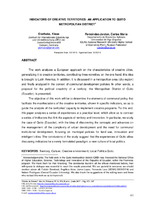| dc.creator | Gierhake, Klaus | |
| dc.creator | Fernández Jardón, Carlos María | |
| dc.date.accessioned | 2023-01-14T19:18:27Z | |
| dc.date.available | 2023-01-14T19:18:27Z | |
| dc.date.issued | 2017-09-01 | |
| dc.identifier.citation | Gierhake, K., Fernández-Jardon, C. M. (2017). Indicators of creative territories: an application to Quito metropolitan district. Visión de Futuro, Revista Científica. Posadas (Misiones): UNaM. FCE. APP; 21(1), 172-187. | es_AR |
| dc.identifier.issn | 1668 – 8708 (Versión en línea) | |
| dc.identifier.other | VF-208 | |
| dc.identifier.uri | https://hdl.handle.net/20.500.12219/4279 | |
| dc.description | Fil: Gierhake, Klaus. JustusLiebigUniversität. Zentrum für internationale Entwicklungs und Umweltforschung; Alemania. | es_AR |
| dc.description | Fil: Fernández Jardón, Carlos María. Universidad de Vigo. Departamento de Economía Aplicada; España. | |
| dc.description | Fil: Fernández Jardón, Carlos María. National Research University Higher. School of Economics Perm, Russian Federation; Rusia. | |
| dc.description.abstract | The work analyzes a European approach on the characteristics of creative cities, generalizing it to creative territories, contributing three novelties: on the one hand, this idea is brought to Latin America; In addition, it is discussed in a metropolitan area (city region) and finally analyzed in the context of communal development policies. In other words, a proposal for the political creativity of a territory, the Metropolitan District of Quito (Ecuador), is presented.
The objective of this work will be to determine the elements of communal policy that facilitate the manifestations of the creative territories, shown in specific indicators, so as to guide the analysis of the territories' capacity to implement creative programs. To this end, this paper analyzes a series of experiences at a practical level, which allow us to contrast a series of indicators that link the aspects of territory and innovation. In particular, we study the case of Quito (Ecuador), with the idea of discovering the concepts and advances on the management of the complexity of urban development and the need for communal institutional development, focusing on municipal policies for land use, innovation and intelligent cities. The conclusions of the study suggest that the experiences of Quito allow discussing indicators for a newly formulated paradigm: a new culture of local politics. | es_AR |
| dc.format | application/pdf | |
| dc.format.extent | 614 KB | |
| dc.language.iso | eng | es_AR |
| dc.publisher | Universidad Nacional de Misiones. Facultad de Ciencias Económicas. Programa de Posgrado en Administración | es_AR |
| dc.relation | info:eu-repo/semantics/altIdentifier/urn/https://visiondefuturo.fce.unam.edu.ar/index.php/visiondefuturo/article/view/141/60 | |
| dc.rights | info:eu-repo/semantics/openAccess | |
| dc.subject | Territory | es_AR |
| dc.subject | Culture | es_AR |
| dc.subject | Creative environment | es_AR |
| dc.subject | Local politics Quito | es_AR |
| dc.title | Indicators of creative territories : an application to Quito metropolitan district | es_AR |
| dc.type | info:eu-repo/semantics/article | es_AR |
| dc.type | info:ar-repo/semantics/artículo | |
| dc.type | info:eu-repo/semantics/publishedVersion | |



